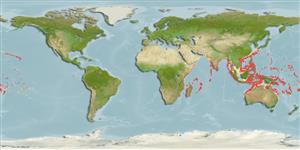>
Eupercaria/misc (Various families in series Eupercaria) >
Lutjanidae (Snappers) > Etelinae
Etymology: Pristipomoides: Greek, pristis = saw + Greek, poma, -atos = cover, operculum + Greek, oides = similar to (Ref. 45335).
More on author: Valenciennes.
Environment: milieu / climate zone / depth range / distribution range
Ekologi
laut bentopelagis; kisaran kedalaman 70 - 300 m (Ref. 9821), usually 125 - 275 m (Ref. 82366). Deep-water; 35°N - 29°S, 34°E - 146°W (Ref. 55)
Indo-Pacific: East Africa to Hawaii and Tahiti, north to southern Japan, south to Australia and Lord Howe Island.
Size / Weight / umur
Maturity: Lm ? range ? - ? cm
Max length : 57.5 cm FL jantan/; (Ref. 107958); common length : 35.0 cm TL jantan/; (Ref. 30573); Berat maksimum terpublikasi: 1.8 kg (Ref. 4887)
Duri punggung (Keseluruhan (total)) : 10; duri punggung lunak (Keseluruhan (total)) : 10 - 11; Duri dubur: 3; Sirip dubur lunak: 8. Interorbital space convex. Jaws about equal, or lower jaw slightly protruding. Bases of dorsal and anal fins without scales, their last soft rays extended into short filaments. Pectoral fins long, reaching level of anus. Scale rows on back parallel to lateral line. Overall color pink or reddish with four oblique orange or yellow bars on the sides; the dorsal and caudal fins yellow.
Adults occur over rocky bottoms (Ref. 30573) of the continental shelf and slope (Ref. 75154). They feed on fishes, shrimps, crabs, cephalopods, miscellaneous benthic invertebrates and pelagic organisms, including urochordates.
Life cycle and mating behavior
Kematangan | Reproduksi, perkembang biakan | Pemijahan | telur-telur | Fecundity | Larva
Allen, G.R., 1985. FAO Species Catalogue. Vol. 6. Snappers of the world. An annotated and illustrated catalogue of lutjanid species known to date. FAO Fish. Synop. 125(6):208 p. Rome: FAO. (Ref. 55)
Status IUCN Red List (Ref. 130435: Version 2024-1)
ancaman kepada manusia
Harmless
penggunaan manusia
Perikanan: komersial; Ikan buruan: ya
Alat, peralatan
laporan khas
muat turun XML
Sumber internet
Estimates based on models
Preferred temperature (Ref.
123201): 12.3 - 23, mean 16.9 °C (based on 356 cells).
Phylogenetic diversity index (Ref.
82804): PD
50 = 0.5005 [Uniqueness, from 0.5 = low to 2.0 = high].
Bayesian length-weight: a=0.01349 (0.00781 - 0.02329), b=2.94 (2.80 - 3.08), in cm total length, based on LWR estimates for this species & Genus-body shape (Ref.
93245).
Trophic level (Ref.
69278): 4.0 ±0.0 se; based on diet studies.
Generation time: 4.7 ( na - na) years. Estimated as median ln(3)/K based on 2
growth studies.
Daya lenting (Ref.
120179): sedang, Waktu penggandaan populasi minimum 1.4 - 4.4 tahun (K=0.23).
Fishing Vulnerability (Ref.
59153): Moderate vulnerability (42 of 100).
Nutrients (Ref.
124155): Calcium = 15.9 [6.9, 40.2] mg/100g; Iron = 0.353 [0.155, 0.749] mg/100g; Protein = 17.1 [15.3, 18.9] %; Omega3 = 0.356 [0.155, 0.696] g/100g; Selenium = 16.6 [7.2, 36.3] μg/100g; VitaminA = 24.9 [5.4, 125.5] μg/100g; Zinc = 0.365 [0.238, 0.567] mg/100g (wet weight);
